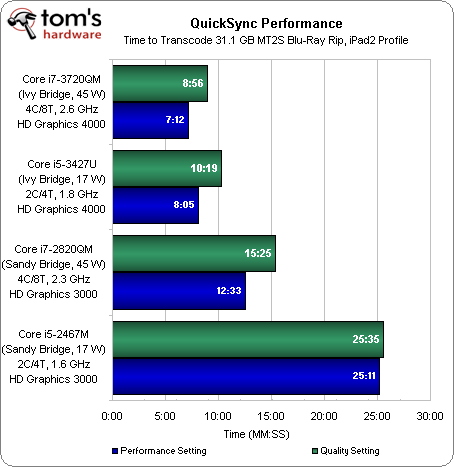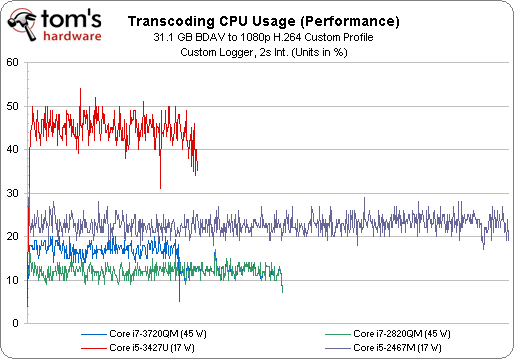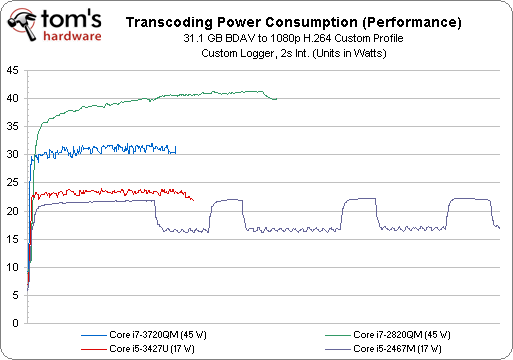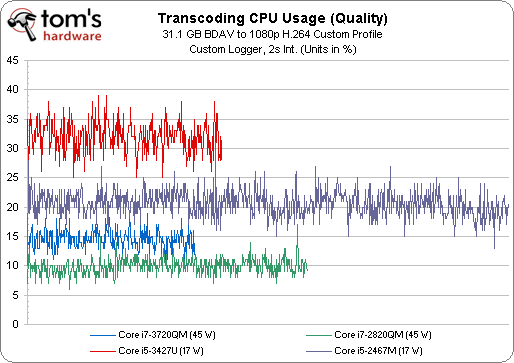Second-Generation Ultrabooks: Faster And Cheaper With Ivy Bridge
Quick Sync: Performance And Power Consumption
Quick Sync was one of our favorite features introduced alongside Intel's Sandy Bridge architecture. With Ivy Bridge, it gets even better. The Core i7-3720QM slashes Blu-ray conversion time by almost 50% (~7:30 minutes) compared to the -2820QM in our lab. The 17 W Core i5-3427U finishes the same task in 10:19. The -2467M takes an astounding 25:35 to process the same workload.
Transcoding video via Quick Sync appears to be a more efficient process now as well. The CPU utilization of our Core i5-3427U was consistently higher than the -2467M, perhaps a result of optimizations the company claims to have made to its graphics engine allowing its x86 cores to do more work. Meanwhile, power consumption increased by only 1-2 W (5-10%).
Performance Preset
Quality Preset
Get Tom's Hardware's best news and in-depth reviews, straight to your inbox.
Current page: Quick Sync: Performance And Power Consumption
Prev Page Integrated Graphics: Image Quality, Examined Next Page Benchmark Results: Blu-ray Playback Efficiency-
sam_fisher It seems that Ivy Bridge's lower TDP and its HD 4000 comes into its own in the notebook/ultrabook market more so than the PC/gaming one.Reply -
sam_fisher crisan_tiberiuthey should use HD 4000 on every intel CPU, i dont get it why they dont ...Reply
The integrated graphics is built into the processor die and the changes between the HD 3000 and 4000 are physical changes, so they can't just change them without changing the whole CPU.
-
mayankleoboy1 crisan_tiberiuthey should use HD 4000 on every intel CPU, i dont get it why they dont ...Reply
Pricing, TDP, segmentation and PROFIT -
crisan_tiberiu sam_fisherThe integrated graphics is built into the processor die and the changes between the HD 3000 and 4000 are physical changes, so they can't just change them without changing the whole CPU. Yes, i know that :)) but when they designed IVY they should have designed every chip with the HD 4000. The HD 4000 is still outperformed by Liano iGPU if you remember...Reply -
tomfreak Cant u put an older/previous generation desktop and benchmark against it? I cant or couldnt get how a fast a 2.0GHz Ivy vs a similar Nehelem Desktop CPU vs desktop core 2 duo CPU. Many of us buy notebook to replace desktop for casual use, we would like to know what it can do vs our old desktop.Reply
Besides get some older AAA games to bench, nobody play BF3 at Ultra books with HD4000. We wanna see what old games we can max out @ full resolution. -
silverblue I think AMD missed a trick with Llano. Instead of throwing four lowly clocked cores at a mobile processor, perhaps two higher clocked cores would've made much more sense. That way, they could possibly sport a higher clock GPU as well within the same TDP.Reply
Trinity's lower powered, higher clocked cores already look to have partly made up for this, but until the 17W variant comes along, there's no real indication of how it'll measure up to IB ULV. However, we do know that AMD pairs the slower GPUs with the slower CPUs and vice versa, so there's little chance of a, say, 2C/2T/1M CPU with the 7660G GPU. -
DjEaZy ... ok... you compare the Llano to Sandy/Ivy bridge in CPU performance, but not in GPU performance? and why not Sandy/Ivy Bridge to Trinity?Reply
... and Adobe Photoshop CS 5? not CS 6?




